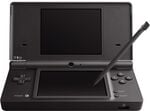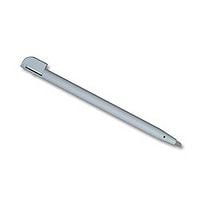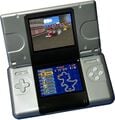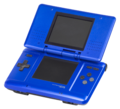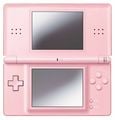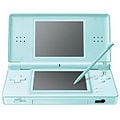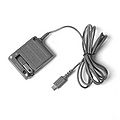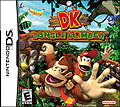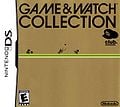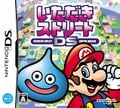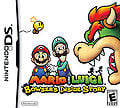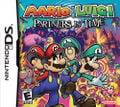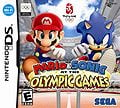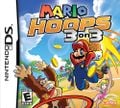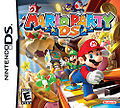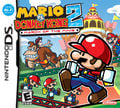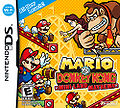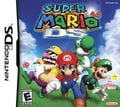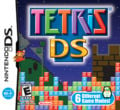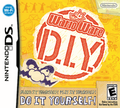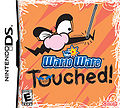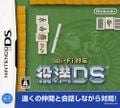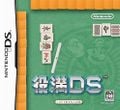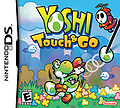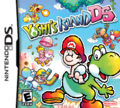|
|
| Line 1: |
Line 1: |
| {{about|the 2004 Nintendo DS game console|the entire series|Nintendo DS line|and|Nintendo DS (disambiguation)}} | | {{FA}} |
| {{merge from|Nintendo DS launch|discuss=Talk:Nintendo DS#Proposed merge with Nintendo DS launch|date=January 2017}} | | {{articleabout|the handheld video game system|the ''[[Mario Kart DS]]'' battle course|[[Nintendo DS (battle course)]]}} |
| {{pp-move|small=yes}}
| | {{System-Infobox |
| {{Infobox information appliance
| | |Image=[[File:Nintendo DS Cropped OF.PNG|250px]]<br>The first commercial model of the '''Nintendo DS'''. |
| | title = Nintendo DS | | |Rel='''Nintendo DS''':<br>{{releasedate|USA|November 21, 2004|Japan|December 2, 2004|Australia|February 24, 2005|Europe|March 11, 2005|China|July 23, 2006}} '''Nintendo DS Lite''':<br>{{releasedate|Japan|March 2, 2006|Australia|June 1, 2006|USA|June 11, 2006|Europe|June 23, 2006|China|June 29, 2006|South Korea|January 18, 2007}} '''Nintendo DSi''':<br>{{releasedate|Japan|November 1, 2008|Australia|April 2, 2009|Europe|April 3, 2009|USA|April 5, 2009<ref>[http://uk.ds.ign.com/articles/954/954922p1.html IGN: US DSi Release Detailed], accessed 2009-02-18</ref>|China|December 19, 2009|South Korea|April 15, 2010}} '''Nintendo DSi XL''':<br>{{releasedate|Japan|November 21, 2009|Europe|March 5, 2010|USA|March 28, 2010|Australia|April 15, 2010}} |
| | aka = iQue DS
| | |Dis=2014 |
| | logo = Nintendo DS Logo.svg
| | |Pre=[[Game Boy Advance]] |
| | logo_size = 250px | | |Suc=[[Nintendo DSi]] |
| | image = Nintendo-DS-Fat-Blue.png
| |
| | image_size = 250px | |
| | caption = A blue original Nintendo DS
| |
| | developer = [[Nintendo]]
| |
| | manufacturer = [[Foxconn]]
| |
| | family = [[Nintendo DS family]]
| |
| | type = [[Handheld game console]]
| |
| | generation = [[Seventh generation of video game consoles|Seventh generation]]
| |
| | releasedate = {{Video game release|NA|November 21, 2004|JP|December 2, 2004|AUS|February 24, 2005|EU|March 11, 2005}}
| |
| | lifespan = 2004–2014<ref name="nintendosales"/>
| |
| | unitssold = 18.79 million <small>({{as of|2016|6|30|lc=y|df=US}})</small>,<ref name="nintendosales"/> with all models combined 154.02 million worldwide <small>({{as of|2016|6|30|lc=y|df=US}})</small><ref name="nintendosales"/> ([[Nintendo DS sales|details]])
| |
| | topgame = ''[[New Super Mario Bros.]]'', {{nowrap|30.80 million}} <small>({{as of|2016|9|30|lc=y|df=US}})</small><ref name="nintendo_topsales">{{cite web|url=https://www.nintendo.co.jp/ir/en/sales/software/ds.html |title=Sales Data — Top Selling Software Sales Units — Nintendo DS Software |publisher=[[Nintendo]] |date=March 31, 2015 |accessdate=May 24, 2014}}</ref>
| |
| | media = [[Nintendo game card]], [[ROM cartridge]] | |
| | cpu = Two [[ARM architecture]] processors | |
| | memory = 4 MB [[RAM]] | |
| | storage = [[Saved game|Cartridge save]]<br>256 KB flash memory | |
| | display = Two [[TFT LCD]], 256 × 192 pixels | |
| | connectivity = [[Wi-Fi]] | |
| | service = [[Nintendo Wi-Fi Connection]] | |
| | compatibility= [[Game Boy Advance]]
| |
| | predecessor = Game Boy Advance {{cn|date=January 2017}} <!-- https://en.wikipedia.org/wiki/Talk:Nintendo_Switch#Pretty_sure_this_is_the_successor_to_Wii_U. --> | |
| | successor = [[Nintendo 3DS]]
| |
| }} | | }} |
| | {{LLQuote|Pick up and play.|European advertisement slogan for the Nintendo DS}} |
|
| |
|
| The '''Nintendo DS'''{{efn|{{nihongo|ニンテンドーDS|Nintendō DS}}}} or simply, '''DS''', is a 32-bit<ref>{{cite book|last1=Furber|first1=Steve|title=ARM System-on-Chip Architecture|isbn=0201675196|page=344}}</ref> dual-screen [[handheld game console]] developed and released by [[Nintendo]]. The device went on sale in [[North America]] on November 21, 2004. The DS, short for "Developers' System" or "Dual Screen",<ref>{{cite web|title=Nintendo DS Frequently Asked Questions|url=http://en-americas-support.nintendo.com/app/answers/detail/a_id/3904/p/606|publisher=Nintendo|accessdate=July 8, 2014}}</ref> introduced distinctive new features to handheld gaming: two [[LCD]] screens working in tandem (the bottom one featuring a [[touchscreen]]), a built-in [[microphone]], and support for [[wireless network|wireless connectivity]].<ref>{{cite web |url=http://www.darkain.com/nintendo_ds/nifi.php |archiveurl=https://web.archive.org/web/20050217195147/http://www.darkain.com/nintendo_ds/nifi.php|archivedate=February 17, 2005 |title=Nintendo DS – WI-FI vs NI-FI |author=Darkain |date=January 21, 2005|accessdate=April 2, 2006}}</ref> Both screens are encompassed within a [[Flip (form)|clamshell]] design similar to the [[Game Boy Advance SP]]. The Nintendo DS also features the ability for multiple DS consoles to directly interact with each other over [[Wi-Fi]] within a short range without the need to connect to an existing wireless network. Alternatively, they could interact online using the now-closed [[Nintendo Wi-Fi Connection]] service. Its main competitor was Sony's [[PlayStation Portable]] as part of the [[History of video game consoles (seventh generation)|seventh generation era]]. | | [[File:DS Logo.svg|left]] The '''[[nwiki:Nintendo DS|Nintendo DS]]''' is a handheld game system released by [[Nintendo]] in 2004. The Nintendo DS is Nintendo's fourth handheld system; its predecessor is the [[Game Boy Advance]]. It features two 3-inch screens. "DS" stands for "Dual Screen" (though, at its conception, it was intended to stand for "Developer's System"). The system introduces many new features to the Nintendo handheld lineup, including a resistive touchscreen, visible operating system GUI (in the form of the main menu), stereo sound output/audio input via microphone, and wireless connection capabilities. It is also the first Nintendo handheld to support 3D polygonal graphics as opposed to only sprites. As with previous major Nintendo handhelds, the DS and DS Lite provides backwards compatibility for Game Boy Advance games (though this does not work with the [[Nintendo DSi]] family), although only limited to single player experiences as the [[Game Boy Advance#Game Link Cable|link cable]] and [[Game Boy Advance#Wireless Adaptor|wireless adapter]] support are missing. The charger provided with the First Generation DS is the same connection as the Gameboy Advance SP. It is also the handheld counterpart of the [[Wii]]. |
|
| |
|
| Prior to its release, the Nintendo DS was marketed as an experimental, "third pillar" in Nintendo's console lineup, meant to complement the Game Boy Advance and [[GameCube]]. However, backward compatibility with Game Boy Advance titles and strong sales ultimately established it as the successor to the Game Boy series.<ref>http://www.nintendojo.com/features/specials/a-pillar-too-many A Pillar Too Many</ref> On March 2, 2006, Nintendo launched the [[Nintendo DS Lite]], a slimmer and lighter redesign of the original Nintendo DS with brighter screens. On November 1, 2008, Nintendo released the [[Nintendo DSi]], another redesign with several hardware improvements and new features. All Nintendo DS models combined have sold 154.02 million units,<ref>As of March 31, 2016</ref> making it the best selling handheld game console to date, and the second [[List of best-selling game consoles|best selling video game console]] of all time.<ref name="nintendosales">{{cite web |url=https://www.nintendo.co.jp/ir/library/historical_data/pdf/consolidated_sales_e1603.pdf |title=Consolidated Sales Transition by Region |accessdate=April 27, 2016 |date=April 27, 2016 |publisher=Nintendo |format=PDF}}</ref><ref name="wired1">Schreier, Jason. (January 4, 2011) [https://www.wired.com/gamelife/2011/01/nintendo-ds-sales/ Nintendo DS Line Outsells PlayStation 2, Nintendo Says | Game|Life]. Wired.com. Retrieved on 2013-08-23.</ref> The [[Nintendo DS line]] was succeeded by the [[Nintendo 3DS line]] in 2011.
| | The DS is the first Nintendo system to include wireless functions, allowing it to link up with other DS's without any wires or add-ons. This was also the first system Nintendo made to go online (''[[Mario Kart DS]]'' being the first Nintendo-made online game), using the [[Nintendo Wi-Fi Connection]]. On the original DS and the DS Lite, WPA encrypted networks are not supported. |
|
| |
|
| {{TOC level|3}} | | The Nintendo DS had the {{button|ds|A}}, {{button|ds|B}}, {{button|ds|L}}, {{button|ds|R}}, {{button|gba|start}} and {{button|gba|select}} buttons from the [[Game Boy Advance]], plus two new buttons: {{button|ds|X}} and {{button|ds|Y}}, making it identical to the [[SNES]]. |
|
| |
|
| ==History==
| | Before the official name's release, Iris was the first codename for the handheld that would be the successor of the Game Boy Advance. Later, it was called Nitro<ref>http://www.nintendo.co.uk/Iwata-Asks/Iwata-Asks-WarioWare-D-I-Y-/Iwata-Asks-WarioWare-D-I-Y-/1-It-Started-Over-Five-Years-Ago/1-It-Started-Over-Five-Years-Ago-214996.html</ref> when the new device created had two screens. |
|
| |
|
| ===Development===
| | The Nintendo DS (including DS Lite, DSi and DSi XL) sold 128.90 million units as of 2010, making it Nintendo's best selling video game console and the highest-selling handheld console in the world. <ref>http://www.nintendo.co.jp/ir/library/historical_data/pdf/consolidated_sales_e1103.pdf</ref><ref>http://www.joystiq.com/2011/01/04/nintendo-ds-is-now-best-selling-console-ever-in-us/</ref> In February of 2011, the DS line was superseded by the [[Nintendo 3DS]]. |
| On November 13, 2003, Nintendo announced that it would be releasing a new game product in 2004. The company did not provide many details, but stated it would not succeed the [[Game Boy Advance]] or [[GameCube]].<ref name="newconsole">{{cite web|url=http://ds.ign.com/articles/541/541729p1.html|title=Nintendo Going Back to the Basics. Full story about the company offering a new system in 2004.|accessdate=October 4, 2007|date=November 13, 2003|publisher=IGN}}</ref> On January 20, 2004, the console was announced under the codename "Nintendo DS".<ref name=janpress>{{cite web|url=http://biz.yahoo.com/bw/040120/206239_1.html |archiveurl=https://web.archive.org/web/20040402004236/http://biz.yahoo.com/bw/040120/206239_1.html |archivedate=April 2, 2004 | title=Nintendo Announces Dual-Screened Portable Game System |date=January 20, 2004 | accessdate=July 10, 2007}}</ref> Nintendo released only a few details at that time, saying that the console would have two separate, 3-inch [[Thin film transistor liquid crystal display|TFT LCD]] display panels, separate processors, and up to 1 gigabit (128 Megabytes) of semiconductor memory.<ref name=janpress/><ref>{{cite web|title=GI Online Interviews NOA's Beth Llewelyn About The Nintendo DS|url=http://www.gameinformer.com/News/Story/200401/N04.0121.1808.42530.htm|archiveurl=https://web.archive.org/web/20070612012800/http://www.gameinformer.com/News/Story/200401/N04.0121.1808.42530.htm|archivedate=June 12, 2007 |date=January 21, 2004|author=Billy Berghammer|accessdate=July 10, 2007}}</ref> Nintendo president [[Satoru Iwata]] said, "We have developed Nintendo DS based upon a completely different concept from existing game devices in order to provide players with a unique entertainment experience for the 21st century."<ref name=janpress/> He also expressed optimism that the DS would help put Nintendo back at the forefront of innovation and move away from the conservative image that has been described about the company in years past.<ref name="thirdpillar">{{cite web|url=http://www.n-sider.com/contentview.php?contentid=515|title=Various Satoru Iwata comments regarding the Nintendo DS|author=Glen Bayer|publisher=N-sider.com|date=March 1, 2004|accessdate=October 4, 2007}}</ref> In March 2004, a document containing most of the console's technical specifications was leaked, also revealing its internal development name, "Nitro."<ref>{{cite web | title=More Nintendo DS (or Nitro?) specs leaked |url=http://it.vibe.co.uk/technology/2003/12/more-nintendo-ds-or-nitro-specs-leaked/ |archiveurl=https://web.archive.org/web/20101106073212/http://it.vibe.co.uk/technology/2003/12/more-nintendo-ds-or-nitro-specs-leaked/ |archivedate=November 6, 2010 |date=March 13, 2004 | author=Kavanagh, Rich | accessdate=July 13, 2007}}</ref> In May 2004, the console was shown in prototype form at [[History of the Electronic Entertainment Expo#2004|E3 2004]], still under the name "Nintendo DS."<ref>{{cite news |title=Nintendo unveiling new portable | url=http://usatoday30.usatoday.com/life/lifestyle/2004-05-11-nintendo-ds_x.htm |date=May 5, 2004 | author=Kent, Steve | accessdate=July 13, 2007 | work=USA Today}}</ref> On July 28, 2004, Nintendo revealed a new design that was described as "sleeker and more elegant" than the one shown at E3 and announced Nintendo DS as the device's official name.<ref>{{cite news |title=Nintendo keeps 'DS' codename, tweaks hardware | url=http://usatoday30.usatoday.com/tech/news/2004-07-28-no-really-its-ds_x.htm |date=July 28, 2004 | accessdate=July 13, 2007 | work=USA Today}}</ref> Following lukewarm GameCube sales, former Nintendo president [[Hiroshi Yamauchi]] stressed the importance of its success to the company's future stating, "If the DS succeeds, we will rise to heaven, but if it fails we will sink to hell."<ref name="Yamauchi=GameScience">{{cite web|title=Nikkei talks with Nintendo's Yamauchi and Iwata|publisher=GameScience |url=http://game-science.com/news/000406.html|deadurl=yes|archiveurl=https://web.archive.org/web/20060127211555/http://game-science.com/news/000406.html|archivedate=January 27, 2006|accessdate=May 27, 2014|quote="If the DS succeeds, we will rise to heaven, but if it fails we will sink to hell." — Hiroshi Yamauchi}}</ref><ref name="Yamauchi-NintendoWorld">{{cite web|title=Iwata, Yamauchi Speak Out on Nintendo DS|url=http://www.nintendoworldreport.com/news/9256/iwata-yamauchi-speak-out-on-nintendo-ds|date=February 13, 2004|first=Jonathan|last=Metts|publisher=Nintendo Worldwide Report|accessdate=May 27, 2014}}</ref>
| |
|
| |
|
| ===Launch===
| | Since May 20th 2014, online play for many Nintendo DS games has been discontinued because the [[Nintendo Wi-Fi Connection]] service has discontinued. However, players can still access the DSi Shop to buy games. <ref> http://www.nintendo.com/whatsnew/detail/vyWpoM6CBIe6FjW8NIY7bvzOrgBURhzw</ref> |
| {{main article|Nintendo DS launch}}
| |
| President Iwata referred to Nintendo DS as "Nintendo's first hardware launch in support of the basic strategy 'Gaming Population Expansion'" because the touch-based device "allows users to play intuitively".<ref name="Message from the President Dec 2008">{{cite web | title=Message from the President: To shareholders and investors | work=Investor Relations Information | publisher=Nintendo Co., Ltd. | location=Japan | date=2008 | url=https://www.nintendo.co.jp/ir/en/message/index.html | deadurl=yes | archiveurl=https://web.archive.org/web/20081221204655/http://www.nintendo.co.jp/ir/en/message/index.html | archivedate=December 21, 2008 | accessdate=November 25, 2015}}</ref> On September 20, 2004, Nintendo announced that the Nintendo DS would be released in North America on November 21, 2004 for [[United States dollar|US$]]149.99.<ref>{{cite web | title=Official Nintendo DS Launch Details | url=http://ds.ign.com/articles/549/549919p1.html |last=Harris|first= Craig |date=September 20, 2004 | accessdate=August 13, 2007}}</ref> It was set to release on December 2, 2004 in Japan (¥15000);<ref name="JAPprice">{{cite web|url=http://ds.ign.com/articles/554/554890p1.html|title=IGN: NDS Japanese Launch Details|accessdate=December 27, 2008}}</ref> on February 24, 2005 in Australia ($199.95);<ref name="AUSprice">{{cite web|url=http://palgn.com.au/nintendo-ds/1885/australian-ds-launch/|title=PALGN: Australian DS Launch|accessdate=December 27, 2008}}</ref> and on March 11, 2005 in Europe (£99.99/€149.99).<ref name="EURprice">{{cite web|url=http://www.gamesindustry.biz/articles/nintendo-claims-most-successful-launch-ever-for-ds-in-australia|title=Nintendo claims most successful launch ever for DS in Australia|accessdate=December 27, 2008}}</ref> The console was released in North America with a midnight launch event at Universal CityWalk EB Games in [[Los Angeles|Los Angeles, California]]. The console was launched quietly in Japan compared to the North America launch; one source cites the cold weather as the reason.<ref>{{cite web|title=NDS Launches in Japan|url=http://ds.ign.com/articles/569/569911p1.html|date=December 1, 2004|author=Gantayat, Anoop|accessdate=July 16, 2007}}</ref> Regarding the European launch, Nintendo President Satoru Iwata said:
| |
| {{quotation | Europe is an extremely important market for Nintendo, and we are pleased we can offer such a short period of time between the US and European launch. We believe that the Nintendo DS will change the way people play video games and our mission remains to expand the game play experience. Nintendo DS caters for the needs of all gamers whether for more dedicated gamers who want the real challenge they expect, or the more casual gamers who want quick, pick up and play fun.<ref name="iwata-ds-quote">{{cite web|url=http://www.ign.com/articles/2005/01/27/europe-ds-launch-title-details|title=Europe DS Launch Title Details|first=Craig|last= Harris|publisher=IGN|date=January 27, 2007|accessdate=October 4, 2007}}</ref>}}
| |
|
| |
|
| ===Promotion===
| | The graphical capability of the DS is said to be on par with the [[Nintendo 64]], albeit with enhanced 3D modeling but more pixelated textures due to lack of texture filtering. |
| The system's promotional slogans revolve around the word "Touch" in almost all countries, with the North American slogan being "Touching is good."<ref name="nbcnews">{{cite web|url=http://www.nbcnews.com/id/6471849/ns/technology_and_science-games/t/nintendo-ds-targets-teens-young-adults/#.V0TbC5MrLao|title=Nintendo DS targets teens, young adults|date=November 15, 2004|accessdate=May 24, 2016}}</ref> | |
|
| |
|
| The Nintendo DS was seen by many analysts to be in the same market as [[Sony]]'s [[PlayStation Portable]], although representatives from both companies have said that each system targets a different audience.{{Citation needed|date=October 2007}} At one point, [[Time (magazine)|''Time'' magazine]] awarded the DS a Gadget of the Week award.<ref>{{cite news|url=http://www.time.com/time/business/article/0,8599,1204187,00.html|title=Time Magazine: Gadget of the Week|accessdate=February 1, 2007 | first=Wilson | last=Rothman | date=June 14, 2006}}</ref>
| | ==Models== |
| | ===Nintendo DS Lite=== |
| | [[File:DSLite.png|thumb|left|150px|A Polar White DS Lite with a stylus.]] |
| | A newer model named the '''Nintendo DS Lite''' was released in 2006 and contains all the features of the original Nintendo DS with some new features such as a significantly brighter screen (with four adjustment options), a lighter weight, and a smaller overall size (having the negative side effect of a regular [[Game Boy Advance]] cartridge protruding out from the bottom, similar to playing a Game Boy or Game Boy Color cartridge in the Game Boy Advance). The Nintendo DS Lite sold 89.19 million units as of 2010{{refneeded}}. It was also the final handheld system to have backwards compatibility with Game Boy Advance games. |
| | {{br}} |
|
| |
|
| At the time of its release in the United States, the Nintendo DS retailed for US $149.99. The price dropped to US $129.99 on August 21, 2005, one day before the anticipated North American releases of ''[[Nintendogs]]'' and ''[[Advance Wars: Dual Strike]]''.
| | ===Nintendo DSi and DSi XL=== |
| | {{main|Nintendo DSi}} |
| | [[File:Black Dsi.jpg|thumb|left|150px|The Nintendo DSi]] |
| | A third model, called the '''Nintendo DSi''', was announced on October 2nd, 2008. It is thinner, lighter, and brighter than the Nintendo DS Lite, having removed the Game Boy Advance slot. However, this means that the Nintendo DS Rumble Pack, which was used with titles such as ''[[Mario & Luigi: Partners in Time]]'', cannot be used. Two cameras, music playback functions, Wi-Fi, internet browser, larger screens, and a Wii-like channel interface were added. Additionally, the console supports WPA encrypted networks. |
|
| |
|
| The console's North American slogan "Touching is good." caused minor controversy, for its inappropriate expression, as "touching" is slang for [[rape]]. As a result, the slogan was changed to "Pick up and play!" in some countries. | | The DSi is also able to download games from the Nintendo DSi Shop, which are then stored on an SD Card or in internal memory. It was released in Japan on November 1st, 2008, in North America on April 5th 2009 and in Europe on April 13th, 2009. The DSi's front has a camera lens, and another, smaller lens is located where the mic was positioned on the Lite, allowing for photos to be taken with the DSi. In 2009, Nintendo later released the [[Nintendo DSi#Nintendo DSi XL|Nintendo DSi XL]], with the "XL" standing for "Extra Large." It is also the heaviest of the four models. <ref>http://www.nintendo.com/whatsnew/detail/Q5D4ti_bPqJO_I0Oup0AMFudaUOLz6C7</ref> |
| | {{br}} |
|
| |
|
| Nine official colors of the Nintendo DS were available through standard retailers. Titanium (silver and black) were available worldwide, Electric Blue was exclusive to North and Latin America. There was also a red version of the DS which was bundled with the game Mario Kart DS. Graphite Black, Pure White, Turquoise Blue, and Candy Pink were available in Japan. Mystic Pink and Cosmic Blue were available in Australia and New Zealand. Japan's Candy Pink and Australia's Cosmic Blue were also available in Europe and North America through a ''Nintendogs'' bundle, although the colors are just referred to as pink and blue; however, these colors were available only for the original style Nintendo DS; a different and more-limited set of colors have been used for the Nintendo DS Lite.
| | ==Stylus== |
| | [[File:Stylus.jpg|thumb|right|A '''Nintendo DS Stylus'''.]] |
| | The '''Stylus''' is a pencil-like accessory that comes included with the [[Nintendo DS]] system. The instrument is often used in conjunction with the touch screen. Usually, the stylus is used to make menu selections, which the player can do by bringing the stylus in contact with their selection on the touch screen. The stylus is often helpful or required in gameplay. For example, ''[[New Super Mario Bros.]]'', ''[[Super Mario 64 DS]]'', and ''[[Wario: Master of Disguise]]'' require the use of the stylus for [[minigame]]s such as [[Wanted!]] and [[Roach Smash]]. The stylus is also necessary to make [[Mini Mario (Mario vs. Donkey Kong)|Mini Mario]] toys [[jump]], in ''[[Mario vs. Donkey Kong 2: March of the Minis]]''. |
|
| |
|
| ===Sales===
| | On the DS, the stylus slot is located on the back, and is inserted downwards, relatively to the DS itself. On the DS Lite and DSi, however, it was relocated to the right side of the system, and is inserted from right to left, relative to the DS Lite or DSi. |
| {{Main article|Nintendo DS sales}}
| |
| As of March 31, 2016, all Nintendo DS models combined have sold 154.02 million units, making it the best selling handheld game console to date, and the second [[List of best-selling game consoles|best selling video game console]] of all time.<ref name="nintendosales"/><ref name="wired1"/>
| |
|
| |
|
| ===Legacy===
| | The stylus for the DS is noticeably thinner than the stylus for the DS Lite. A DS generally comes with two styluses, and extras can be purchased from stores or special ones from promotions. |
| The success of the DS paved the way for its successor, the [[Nintendo 3DS]], a handheld gaming console with a similar dual-screen setup. It can display images on the top screen in a three-dimensional look.<ref name="Nintendo to unveil 3-D gaming console">{{cite web|last=Frum|first=Larry|title=Nintendo to unveil 3-D gaming console|url=http://www.cnn.com/2010/TECH/03/23/nintendo.3d/index.html|publisher=CNN.com|accessdate=September 6, 2013}}</ref> | |
|
| |
|
| On January 29, 2014, Nintendo announced that Nintendo DS games would be added to the [[Wii U]] Virtual Console,<ref>{{cite web |url= http://www.polygon.com/2014/1/29/5359746/nintendo-ds-games-coming-to-wii-u-virtual-console
| | ===See also=== |
| |title= Nintendo DS games coming to Wii U Virtual Console|last1= McWhertor|first1= Michael |date= January 29, 2013|website= Polygon |accessdate=January 30, 2014}}</ref> with the first game, ''[[Brain Age: Train Your Brain in Minutes a Day!]]'', being released in Japan on June 3, 2014.<ref name="VCJPrelease">{{cite news | url=http://www.eurogamer.net/articles/2014-06-04-nintendos-first-ds-title-for-wii-u-now-available-in-japan | title=Nintendo's first DS title for Wii U now available in Japan | first=Tom | last=Phillips | publisher=Eurogamer.net |date=June 4, 2014 | accessdate=June 4, 2014}}</ref>
| | *[[Game System Accessories#Styluses|Mario themed Stylus Pens]] |
| | {{br}} |
|
| |
|
| ==Games== | | ==Microphone== |
| {{see also|List of Nintendo DS games}}
| | [[File:Microphone dslite.jpg|x100px|thumb|right|The '''Microphone''' on the Nintendo DS Lite.]] |
| {{refimprove section|date=May 2015}} | | The '''Microphone''' is a feature on the [[Nintendo DS]]. On the original DS, it is at the lower left-hand corner, right below the screen. On the DS Lite, it is at the middle in between the two screens. Its function is to accept audio input. On the DSi, this position is replaced by the Camera, and the Microphone was moved about 2 cm to the right. Blowing into it will allow events to happen in the game that the player is playing, such as [[Toad Jump]]. In other games, the player must say words into the Microphone. In ''[[Mario & Sonic at the Olympic Games]]'', the player must clap into the mic to gain inspiration from the crowd in Long Jump and Triple Jump. Also, in the game ''[[Mario & Luigi: Bowser's Inside Story]]'', the player needs to use the microphone at certain points, such as breathing out fire as Giant Bowser. |
| | {{br}} |
|
| |
|
| ===Compatibility=== | | ==Appearances in the ''Mario'' series== |
| [[File:Game-Boy-Nintendo-DS-Slots.jpg|thumb|[[Game Boy Advance]] game slot on Game Boy Advance SP (below) and Nintendo DS Lite (above).]]
| | ===''WarioWare: Touched!''=== |
| The Nintendo DS is [[backward compatibility|backward compatible]] with [[Game Boy Advance]] (GBA) cartridges. The smaller [[Nintendo Game Card|Nintendo DS game cards]] fit into a slot on the top of the system, while Game Boy Advance games fit into a slot on the bottom of the system. The Nintendo DS is not backward compatible with games for the [[Game Boy Color]] and the original [[Game Boy]] {{Citation needed|date=March 2014}} because the Sharp [[Zilog Z80|Z80]] compatible processor is not included and the console has physical incompatibility with Game Boy and Game Boy Color games. The original Game Boy sound processor used in the older systems is still included, and indeed necessary for some GBA games that use the older sound hardware. {{Citation needed|date=September 2009}} | | The plot of ''[[WarioWare: Touched!]]'' revolves around [[Wario]] obtaining a gaming console resembling a Nintendo DS and using it to market new microgames. Occasionally, a Nintendo DS can be seen in the [[Pushing Buttons]] microgame. |
|
| |
|
| The handheld does not have a port for the Game Boy Advance Link Cable, so multiplayer or GameCube–Game Boy Advance link-up modes are not available in Game Boy Advance titles. Only single-player mode is supported on the Nintendo DS, as is the case with Game Boy Advance games played via the Virtual Console on the 3DS and Wii U.
| | ===''Mario Kart DS''=== |
| | One of the battle courses in ''[[Mario Kart DS]]'' is the [[Nintendo DS (battle course)|Nintendo DS]]. Also some billboards in Mario Circuit features a picture of the DS. |
|
| |
|
| The Nintendo DS only uses one screen when playing Game Boy Advance games. The user can configure the system to use either the top or bottom screen by default. The games are displayed within a black border on the screen, due to the slightly different screen resolution between the two systems (256 × 192 px for the Nintendo DS, and 240 × 160 px for the Game Boy Advance).
| | ===[[Mario & Luigi (series)|''Mario & Luigi'' series]]=== |
| | ====''Mario & Luigi: Partners in Time''==== |
| | [[File:Shroob2.jpg|200px|thumb|right|A Shroob holding a silver, flip-top communicator.]] |
| | In ''[[Mario & Luigi: Partners in Time]]'', [[Shroob]]s call [[Shroob UFO]]s by using a silver, flip-top communicator. Because the Nintendo DS has the capability to send verbal messages to friends, this may be a reference to the Nintendo DS. Additionally, [[Professor Elvin Gadd]] is shown to own a [[DS Time Radar|Nintendo DS with an apparent time radar]] he used to locate [[Princess Peach]] at the beginning of the game; he later uses the DS to operate the [[Hydrogush 4000]]. |
|
| |
|
| Nintendo DS games inserted into the top slot are able to detect the presence of specific Game Boy Advance games in the bottom slot. In many such games, either stated in the game during gameplay or mostly explained in the games' instruction manuals, extra content can be unlocked or added by starting the Nintendo DS game with the appropriate Game Boy Advance game inserted. Among those games were the popular [[Pokémon Diamond and Pearl|''Pokémon Diamond'' and ''Pearl'']] or ''[[Pokémon Platinum]]'', that allowed the player to find more/exclusive Pokémon in the wild if a suitable Game Boy Advance cartridge was inserted.<ref>{{cite web|url=http://bulbapedia.bulbagarden.net/wiki/Dual-Slot_Mode|title=Dual-slot mode|publisher=|accessdate=November 1, 2014}}</ref> Some of the content can stay permanently, even when the GBA game has been removed after content has been added.
| | ====''Mario & Luigi: Bowser's Inside Story''==== |
| | In ''[[Mario & Luigi: Bowser's Inside Story]]'', the [[Emoglobin]]s that run [[The Gauntlet|the Gauntlet]] and [[Cholesteroad]] are shaped like DS systems. Additionally, [[Dark Fawful]] uses a device that resembles a Nintendo DS to track down the [[Dark Star]]. |
|
| |
|
| Additionally, GBA slot can be used to house expansion paks, such as the [[List of Nintendo DS Rumble Pak games|Rumble Pak]], the [[Nintendo DS Browser#DS memory expansion pak|Nintendo DS Memory Expansion Pak]], and the Guitar Grip for the ''[[Guitar Hero: On Tour series|Guitar Hero: On Tour]]'' series. The Nintendo DSi and the DSi XL do not have a second cartridge slot and cannot play Game Boy Advance games, or ''[[Guitar Hero: On Tour series|Guitar Hero: On Tour]]''.
| | ===''WarioWare: Smooth Moves''=== |
| | In ''[[WarioWare: Smooth Moves]]'', a Nintendo DS appears in the [[microgame]]s [[Brain Age]], and [[Wario Hunting]] as one of the possible baits. |
|
| |
|
| ===Regional division=== | | ===''Super Paper Mario''=== |
| The Nintendo DS is [[regional lockout|region free]] in the sense that any console will run a Nintendo DS game purchased anywhere in the world; however, the Chinese version games can only be played on the Chinese iQue DS, whose larger firmware chip contains the required [[Chinese character]] glyph images. Although the Nintendo DS of other regions cannot play the Chinese games, the iQue DS can play games of other regions. Also, as with Game Boy games, some games that require both players to have a [[Nintendo DS game card]] for multiplayer play will not necessarily work together if the games are from different regions (e.g. a Japanese Nintendo DS game may not work with a North American Nintendo DS game, even though some titles, such as ''Mario Kart DS'' and ''Pokémon Diamond'' and ''Pearl'' versions are mutually compatible). With the addition of the [[Nintendo Wi-Fi Connection]], certain games can be played over the Internet with users of a different region game.
| | ''[[Super Paper Mario]]'' includes a computer console called the [[Dining Specializer]], which is modeled after the Nintendo DS Lite (and can also be abbreviated "DS"). There is also a two-screened handheld that resembles a Nintendo DS known as a [[Training Machine]], which the fortune teller [[Merluvlee]] wanted to use to train her brain (which, in turn, is a reference to the popular DS title, ''[[Brain Age]]'' and in PAL regions "Brain Training"). |
|
| |
|
| Some Wi-Fi enabled games (e.g. ''Mario Kart DS'') allow the selection of opponents by region. The options are "Regional" ("Continent" in Europe) and "Worldwide", as well as two non-location specific settings. This allows the player to limit competitors to only those opponents based in the same geographical area. This is based on the region code of the game in use.{{Citation needed|date=October 2008}}
| | ===''Mario Strikers Charged''=== |
| | In ''[[Mario Strikers Charged]]'', Strikers' Times are shown on the Touch Screen of a Nintendo DS Lite. |
|
| |
|
| The Nintendo DSi, however, has a region lock for the DSiWare downloadable games, as well as DSi-specific cartridges. It still runs normal DS games of any region, however.
| | ===''Mario Party DS''=== |
| | In ''[[Mario Party DS]]'' when the player defeats [[Bowser]] at the end of the story mode, the five [[Sky Crystal]]s join and form something like a crystal [[Nintendo DS]], unlocking [[Triangle Twisters]]. |
|
| |
|
| ===Media specifications=== | | ===''Super Smash Bros. series''=== |
| {{Main article|Nintendo game card}}
| | ====''Super Smash Bros. Brawl''==== |
| | One of the names that can appear whenever a player presses the random button when they're naming their custom stage is "DS". Also, a stage based on the [[PictoChat]] included in the Nintendo DS makes an appearance in ''[[Super Smash Bros. Brawl]]'', complete with its very own DS emblem. Finally, in the Trophy Hoard option, a black Nintendo DS Lite appears in the background with the presents. |
|
| |
|
| Nintendo DS games use a proprietary [[solid state (electronics)|solid state]] [[mask ROM]] in their game cards.<ref name="darkfader">{{cite web|url=http://files.darkfader.net/ds/files/cartridge.txt|title=First Nintendo DS cartridge information|first=Rafael|last=Vuijk|publisher=Dark Fader (Rafael Vuijk)|date=October 11, 2006|accessdate=February 10, 2010}}</ref> The mask ROM chips are manufactured by Macronix and have an access time of 150 [[nanoseconds|ns]].<ref name="gaingame">{{cite web|url=http://blog.gaingame.com/2010/01/31/nintendo-disassembly-3/|title=Nintendo: NDS Disassembly|date=January 31, 2010|publisher=GainGame's Blog|accessdate=February 10, 2010}}{{Unreliable source?|date=September 2011}}</ref> Cards currently range from 8–512 [[mebibyte|MiB]] (64 [[mebibit|Mib]] to 4 [[gibibit|Gib]]) in size (although data on the maximum capacity has not been released).<ref>''[[Ni no Kuni: The Another World]]'' was the first DS game to use a 4-gigabit card {{cite web|url=http://gonintendo.com/?p=94312 |title=GoNintendo: Level 5's press conference – massive info roundup (Fantasy Life announced, Ninokuni's massive DS cart, and much more!)}}</ref><ref>{{cite web|url=http://www.cubed3.com/news/8133/|title=E3 2007 News|Archaic Sealed Heat (Nintendo DS) RPG Details|author=Adam Riley|publisher=Cubed3.com|date=July 15, 2007 |accessdate=November 4, 2007}}</ref> Larger cards have a 25% slower data transfer rate than more common smaller cards.<ref>{{cite web|url=http://blogs.ign.com/MechAssaultDS/2006/06/16/21863/|title=MechAssault DS Developer Diary|author=Sara Guinness|publisher=IGN|date=June 16, 2006|accessdate=November 4, 2007}}</ref> The cards usually have a small amount of [[flash memory]] or an [[EEPROM]] to save user data such as game progress or high scores. However, there are few games that have no save memory such as [[Electroplankton]]. The game cards are {{convert|35|x|33|x|3.8|mm|in|abbr=on}} (about half the width and depth of Game Boy Advance cartridges) and weigh around 3.5 g ({{fract|8}} oz).
| | ====''Super Smash Bros. for Nintendo 3DS''==== |
| | ''[[Super Smash Bros. for Nintendo 3DS]]'' features a successor to the original PictoChat stage, [[PictoChat 2]]. |
|
| |
|
| ==Hardware== | | ===''Donkey Kong Country Returns''=== |
| {{See also|Special versions of the Nintendo DS}}
| | In ''[[Donkey Kong Country Returns]]'', if left idle for long enough, [[Donkey Kong]] will pull out a Nintendo DS Lite to play a game. |
| [[File:Nintendo-DS-Styli.jpg|thumb|Stylus for the DS Lite]] | |
|
| |
|
| The Nintendo DS<ref name="problemkaputt.de">{{cite web|url=http://problemkaputt.de/gbatek.htm#dstechnicaldata|title=GBATEK - GBA/NDS Technical Info|publisher=|accessdate=30 December 2016}}</ref> design resembles that of the multi-screen games from the [[Game & Watch]] line, such as ''[[Donkey Kong (Game & Watch)|Donkey Kong]]'' and ''[[Zelda Game & Watch|Zelda]]'', which was also made by Nintendo.
| | ===''Luigi's Mansion: Dark Moon''=== |
| | In ''[[Luigi's Mansion: Dark Moon]]'', [[Luigi]] uses a device called the [[Dual Scream]] to communicate with [[Professor Elvin Gadd]]. The Dual Scream is essentially the equivalent of the [[Game Boy Horror]] (similar to a [[Game Boy Color]]) that Luigi uses in ''[[Luigi's Mansion]]''. |
|
| |
|
| The lower display of the Nintendo DS is overlaid with a touchscreen designed to accept input from the included [[stylus (computing)|stylus]], the user's fingers, or a curved plastic tab attached to the optional wrist strap. The touchscreen lets users interact with in-game elements more directly than by pressing buttons; for example, in the included chatting software, [[PictoChat]], the [[stylus (computing)|stylus]] is used to write messages or to draw.
| | ==Galleries== |
| | ===System gallery=== |
| | <gallery> |
| | Nintendo ds prototype.jpg|Prototype model shown at E3 2004. |
| | Ds GBA.jpg|Nintendo DS backwards compatibility with the [[Game Boy Advance]]. |
| | DS Electric Blue.png|Electric Blue Nintendo DS. |
| | Nintendo DSI Black.png|A black Nintendo DS Lite. |
| | Pink Nintendo Lite.jpg|A pink Nintendo DS Lite. |
| | DS Lite Turquoise.jpg|A turquoise Nintendo DS Lite. |
| | Nintendo Lite Charger.jpg|A regular North American charger for the Nintendo DS Lite. |
| | DS Logo.svg|The system's logo. |
| | Nintendo DS System Menu.png|The home menu (Nintendo DS and Nintendo DS Lite models) |
| | </gallery> |
|
| |
|
| The handheld features four lettered buttons (X, Y, A, B), a directional pad, and Start, Select, and Power buttons. On the top of the device are two shoulder buttons, a game card slot, a stylus holder and a power cable input. The bottom features the Game Boy Advance game card slot. The overall button layout resembles that of the [[Super Nintendo Entertainment System]] controller. When using backward compatibility mode on the DS, buttons X and Y and the touchscreen are not used as the Game Boy Advance line of systems do not feature these controls.
| | ===Game gallery=== |
| | <center><i><gallery> |
| | File:Cover_DKRDS.png|[[Diddy Kong Racing DS]] |
| | File:DKJungleClimber.jpg|[[DK: Jungle Climber]] |
| | File:Game Watch Collection box art.jpg|[[Game & Watch Collection]] |
| | File:Orig_ita01.jpg|[[Itadaki Street DS]] |
| | File:Bowsersinsidestorycover.jpg|[[Mario & Luigi: Bowser's Inside Story]] |
| | File:MarioLuigiPartnersTime.jpg|[[Mario & Luigi: Partners in Time]] |
| | File:MnSDS boxart.jpg|[[Mario & Sonic at the Olympic Games (Nintendo DS)|Mario & Sonic at the Olympic Games]] |
| | File:MSOWGDScover.PNG|[[Mario & Sonic at the Olympic Winter Games (Nintendo DS)|Mario & Sonic at the Olympic Winter Games]] |
| | File:Mariohoops3on3_boxart.jpg|[[Mario Hoops 3-on-3]] |
| | File:Mario Kart DS Box (North America).png|[[Mario Kart DS]] |
| | File:MPDSNA.jpg|[[Mario Party DS]] |
| | File:Mvsdk2motmcoverart.jpg|[[Mario vs. Donkey Kong 2: March of the Minis]] |
| | File:MvsDKMLM.jpg|[[Mario vs. Donkey Kong: Mini-Land Mayhem!]] |
| | File:NewSuperMarioBrothers.jpg|[[New Super Mario Bros.]] |
| | File:Sm64ds.jpg|[[Super Mario 64 DS]] |
| | File:Superpeach.jpg|[[Super Princess Peach]] |
| | File:Tetris_DS_NA_Box_Art.jpg|[[Tetris DS]] |
| | File:250px-Wariods.jpg|[[Wario: Master of Disguise]] |
| | File:USWarioDIY.png|[[WarioWare: D.I.Y.]] |
| | File:WWDS.jpg|[[WarioWare: Touched!]] |
| | File:Wi-Fi_Taiou_Yakuman_DS.jpg|[[Yakuman DS|Wi-Fi Taiou Yakuman DS]] |
| | File:YakumanDScover.jpg|[[Yakuman DS]] |
| | File:YoshiTouchGo.jpg|[[Yoshi Touch & Go]] |
| | File:YI2boxart.jpg|[[Yoshi's Island DS]] |
| | </gallery></i></center> |
|
| |
|
| It also has [[stereophonic sound|stereo]] speakers providing [[virtual surround|virtual surround sound]] (depending on the software) located on either side of the upper display screen. This is a first for a Nintendo handheld, as the [[Game Boy line]] of systems has only supported stereo sound through the use of headphones or external speakers. A built-in microphone is located below the left side of the bottom screen. It has been used for a variety of purposes, including [[speech recognition]], chatting online between and during gameplay sessions, and [[minigame]]s that require the player to blow or shout into the microphone.
| | ==Trivia== |
| | | [[File:Pink_Ribbon_DS_Lite.jpg|x100px|thumb|right|The Pink Ribbon Nintendo DS Lite.]] |
| ===Models=== | | *If the DS or DS Lite is turned on on the date that the user has set as their birthday, a high pitched chime will play. The DSi and DSi XL will not do this. |
| {{main article|Nintendo DS family}}
| | *At one point, a special "Pink Ribbon" Nintendo DS Lite was released in late September 2008. For every one bought, $5 would be donated to the [[wikipedia:Inflammatory Breast Cancer Association|Inflammatory Breast Cancer Association]]. |
| {{see also|List of Nintendo DS colors and styles}}
| | *One of the possible names for the DS was ''City Boy''. This name made it possible for Nintendo to continue the Game Boy brand (seen as a child's toy) while trying to appeal to an urban young adult crowd. |
| [[File:Nintendo-DS-Lite-w-stylus.png|thumb|150px|[[Nintendo DS Lite]]]] | | *The Nintendo DS is the only handheld system to have neither a [[Player's Choice]] or [[Nintendo Selects]] label on select video games. |
| | |
| The {{Nihongo|'''[[Nintendo DS Lite]]'''|ニンテンドーDS Lite|Nintendō Dī Esu Raito}} is the first redesign of the Nintendo DS. While retaining the original model's basic characteristics, it features a sleeker appearance, and brighter screens. Nintendo considered a larger model of the Nintendo DS Lite for release, but decided against it as sales of the original redesign were still strong. It was the final DS to have backwards compatibility with Game Boy Advance games.<ref>{{cite web | title=DSi XL Was Once DS Lite XL | url=http://uk.ds.ign.com/articles/105/1054873p1.html | accessdate=January 2, 2010}}</ref> As of March 31, 2014, shipments of the DS Lite have reached 93.86 million units worldwide, according to Nintendo.<ref name="nintendosales"/> | |
| | |
| [[File:Nintendo-DSi-Bl-Open.png|thumb|150px|[[Nintendo DSi]]]]
| |
| The {{Nihongo|'''[[Nintendo DSi]]'''|ニンテンドーDSi|Nintendō DSi}} is the second redesign of the Nintendo DS. It is based on the unreleased larger Nintendo DS Lite model. While similar to the previous DS redesign, new features include two inner and outer 0.3 megapixel digital cameras, a larger 3.25 inch display, internal and external content storage, compatibility with WPA wireless encryption, and connectivity to the Nintendo DSi Shop. Unlike the Nintendo DS and Nintendo DS Lite, backwards compatibility with Game Boy Advance games was removed.
| |
| | |
| The '''[[Nintendo DSi XL]]''' (DSi LL in Japan) is a larger design of the Nintendo DSi, and the first model of the Nintendo DS family of consoles to be a size variation of a previous one.<ref name=Briefing>{{cite web|url=https://www.nintendo.co.jp/ir/en/library/events/091030/09.html|title=Corporate Management Policy Briefing / Semi-annual Financial Results Briefing|accessdate=November 9, 2009|date=October 30, 2009|publisher=Nintendo|pages=9–10|location=Minami-ku, Kyoto}}</ref> It features larger screens with wider view angles, improved battery life, and a greater overall size than the original DSi.<ref name=fourth>{{cite web|url=http://www.gamespot.com/news/dsi-xl-hits-us-and-eu-q1-2010-ds-sales-top-113-million-6238345|title=DSi XL hits US & EU Q1 2010, DS sales top 113 million|accessdate=October 29, 2009|author=Tor Thorsen|date=October 29, 2009|work=[[GameSpot]]|publisher=[[CBS Interactive]]|location=[[San Francisco]]}}</ref><ref name="Christopher2009a">{{cite web|url=http://www.mcvuk.com/news/read/nintendo-reveals-dsi-ll|title=Nintendo reveals DSi LL|accessdate=November 9, 2009|author=Christopher Dring|date=October 29, 2009|work=[[Market for Home Computing and Video Games]]|publisher=Intent Media|location=United Kingdom}}</ref> While the original DSi was specifically designed for individual use, Nintendo president Satoru Iwata suggested that DSi XL buyers give the console a "steady place on a table in the living room", so that it might be shared by multiple household members.<ref name=Briefing/>
| |
| | |
| ===Technical specifications===
| |
| | |
| {| class="wikitable"
| |
| |-
| |
| ! Mass !! Dimensions !! Display !! [[display resolution|Resolution]] !! CPU !! RAM !! Input !! Voltage !! Battery !! Storage !! Wireless connectivity
| |
| | |
| |-
| |
| | {{convert|275|g|oz|abbr=on}}
| |
| || 148.7 mm wide × 84.7 mm deep × 28.9 mm high (5.85 in. × 3.33 in. × 1.13 in.)
| |
| || Two [[thin film transistor liquid crystal display|TFT LCD]] screens:
| |
| {{convert|62|x|46|mm|in|abbr=on}}, {{convert|77|mm|in|abbr=on}} diagonal, 0.24 mm [[dot pitch]], [[List of monochrome and RGB palettes#18-bit RGB|18-bit depth]] (262,144 colors), 21 mm gap between screens (≈92 lines).
| |
| || 256 × 192 [[pixel]]s
| |
| || Two [[ARM architecture|ARM]] processors:
| |
| *32 bit [[ARM9|ARM946E-S]] main CPU; 67 MHz clock speed. Processes gameplay mechanisms and video rendering
| |
| *32 bit [[ARM7]]TDMI coprocessor; 33 MHz clock speed. Processes sound output, Wi-Fi support and takes on second-processor duties in Game Boy Advance mode
| |
| || 4 MB (expandable via the Game Boy Advance slot, only officially used by the [[Nintendo DS Browser|Opera web browser]]).
| |
| ||
| |
| * Power button
| |
| * 8 digital buttons
| |
| * D-pad
| |
| * [[Resistive touchscreen]] (lower screen only)
| |
| * Microphone
| |
| || 1.65 v
| |
| || Rechargeable 850 mAh [[lithium-ion battery]].
| |
| || 256 kB of serial flash memory
| |
| || Built-in [[IEEE 802.11|802.11]] Wireless Network Connection ([[Wired Equivalent Privacy|WEP]] encryption support only)<ref>{{cite web |url=https://www.nintendo.com/consumer/wfc/en_na/ds/routerInfo.jsp |title=Nintendo DS and Nintendo DS Lite – Wireless Router Information |publisher=Nintendo – Customer Service}}</ref>
| |
| |}
| |
| | |
| The system's [[3D computer graphics|3D]] hardware<ref name="problemkaputt.de"/><ref>http://twvideo01.ubm-us.net/o1/vault/gdc07/slides/S3727i1.pdf</ref> consist of Rendering Engine and Geometry Engine which perform [[transform, clipping, and lighting|transform and lighting]], Transparency Auto Sorting, Transparency Effects, Texture Matrix Effects, 2D Billboards, Texture Streaming, texture-coordinate transformation, perspective-correct [[texture mapping]], per-pixel Alpha Test, per-primitive [[alpha compositing|alpha blending]], texture blending, Gouraud Shading, [[cel-shaded animation|cel shading]], [[z-buffering]], W-Buffering, 1bit Stencil Buffer, per-vertex directional lighting and simulated point lighting, Depth Test, Stencil Test, Render to Texture, Lightmapping, Environment Mapping, Shadow Volumes, Shadow Mapping, Distance Fog, Edge Marking, Fade-In/Fade-Out, Edge-AA. Sprite special effects: scrolling, scaling, rotation, stretching, shear. However, it uses point ([[nearest-neighbor interpolation|nearest neighbor]]) [[texture filtering]], leading to some titles having a blocky appearance. Unlike most 3D hardware, it has a set limit on the number of triangles it can render as part of a single scene; the maximum amount is about 6144 vertices, or 2048 triangles per frame. The 3D hardware is designed to render to a single screen at a time, so rendering 3D to both screens is difficult and decreases performance significantly. The DS is generally more limited by its polygon budget than by its pixel fill rate. There are also 512 kilobytes of texture memory, and the maximum texture size is 1024 × 1024 pixels.
| |
| | |
| The system has 656 kilobytes of video memory<ref>{{cite web | title=A guide to homebrew development for the Nintendo DS | url=http://osdl.sourceforge.net/main/documentation/misc/nintendo-DS/homebrew-guide/HomebrewForDS.html|accessdate=July 16, 2009}}</ref> and two [[2D computer graphics|2D]] engines (one per screen). These are similar to (but more powerful than) the [[Game Boy Advance]]'s single 2D engine.
| |
| | |
| The Nintendo DS has compatibility with [[Wi-Fi]] ([[IEEE 802.11 (legacy mode)]]). Wi-Fi is used for accessing the [[Nintendo Wi-Fi Connection]], compete with other users playing the same Wi-Fi compatible game, PictoChat<ref>{{cite web|url=http://masscat.afraid.org/ninds/proto_info.php |archiveurl=https://web.archive.org/web/20090202194241/http://masscat.afraid.org/ninds/proto_info.php |archivedate=February 2, 2009 |title=Nintendo DS ni-fi protocol information |publisher=Web.archive.org |date=February 2, 2009 |accessdate=September 11, 2012}}</ref> or with a special cartridge and RAM extension, browse the internet.
| |
| | |
| Nintendo claims the battery lasts a maximum of 10 hours under ideal conditions on a full four-hour charge. Battery life is affected by multiple factors including speaker volume, use of one or both screens, use of wireless connectivity, and use of backlight, which can be turned on or off in selected games such as ''[[Super Mario 64 DS]]''. The battery is user-replaceable using only a Phillips-head screwdriver. After about 500 charges the battery life starts dropping.<ref>[https://www.nintendo.com/consumer/systems/ds/battery_faq.jsp | Nintendo – Customer Service | Nintendo DS – Charging the Battery<!-- Bot generated title -->]</ref> | |
| | |
| Users can close the Nintendo DS system to trigger its 'sleep' mode, which pauses the game that is being played and saves battery life by turning off the screens, speakers, the wireless communications; however, closing the system while playing a Game Boy Advance game will not put the Nintendo DS into sleep mode, and the game will continue to run normally. Certain DS games (such as ''[[Animal Crossing: Wild World]]'') also will not pause but the backlight, screens, and speakers will turn off. Additionally, when saving the game in certain games,<ref>[[Pokémon Diamond and Pearl|''Pokémon Diamond'' and ''Pearl'']], ''[[Zoo Tycoon DS]]'', ''[[SimCity DS]]'', ''[[Tiger Woods PGA Tour]]'', ''[[Digimon World Dawn]]'', ''[[Mega Man Battle Network 5]]'', or ''[[The Legendary Starfy]]''</ref> the DS will not go into sleep mode.<ref>{{cite web|url=http://www.consolewerks.co.uk/console%20info/nintendo-ds-information.html |title=Nintendo DS Fitting Guides, NDSL Repair Guides |publisher=Consolewerks.co.uk |date= |accessdate=September 11, 2012}}</ref> Some games, such as [[The Legend of Zelda: Phantom Hourglass]] even use the closing motion needed to enter sleep mode as an unorthodox way of solving puzzles.
| |
| | |
| ===Accessories===
| |
| {{Main article|Nintendo DS accessories}}
| |
| Although the secondary port on the Nintendo DS does accept and support Game Boy Advance cartridges (but not Game Boy or Game Boy Color cartridges), Nintendo has emphasized that its main intention for its inclusion was to allow a wide variety of accessories to be released for the system, the Game Boy Advance compatibility titles being a logical extension.{{citation needed|date=October 2012}}
| |
| | |
| Due to the lack of a second port on the Nintendo DSi, it is not compatible with any accessory that uses it.
| |
| | |
| ====Rumble Pak====
| |
| {{Main article|Rumble Pak#Nintendo DS}}
| |
| The Rumble Pak was the first official expansion slot accessory. In the form of a Game Boy Advance cartridge, the Rumble Pak vibrates to reflect the action in compatible games, such as when the player bumps into an obstacle or loses a life. It was released in North America and Japan in 2005 bundled with ''[[Metroid Prime Pinball]]''.<ref>{{cite web | url=https://store.nintendo.com/ | title=Nintendo Online Store|accessdate=April 2, 2006}}</ref> In Europe, it was first available with the game ''[[Magnetica|Actionloop]]'', and later ''Metroid Prime Pinball''. The Rumble Pak was also released separately in those regions.
| |
| | |
| ====Headset====
| |
| The Nintendo DS Headset is the official headset for the Nintendo DS. It plugs into the headset port (which is a combination of a standard 3.5mm(1/8-inch) headphone connector and a proprietary microphone connector) on the bottom of the system. It features one earphone and a microphone, and is compatible with all games that use the internal microphone. It was released alongside [[Pokémon Diamond and Pearl|''Pokémon Diamond'' and ''Pearl'']] in Japan, North America, and Australia.
| |
| | |
| ====Browser====
| |
| {{Main article|Nintendo DS Browser}}
| |
| On February 15, 2006, Nintendo announced a version of the [[cross-platform]] web browser [[Opera (web browser)|Opera]] for the DS system.<ref name="Opera PR">{{cite press release|url=http://www.opera.com/press/releases/2006/02/15/|title=Giving gamers two windows to the Web: The Opera Browser for Nintendo DS |date=February 15, 2006|publisher=Opera Software|accessdate=April 2, 2006}}</ref> The browser can use one screen as an overview, a zoomed portion of which appears on the other screen, or both screens together to present a single tall view of the page.<ref name="Opera Berit">{{cite web|author=Berit Hanson |date=February 16, 2006|url=http://my.opera.com/berit/blog/show.dml/146280|title=Opera for Nintendo DS|work=Berit's Blog|accessdate=July 3, 2006}}</ref> The browser went on sale in Japan and Europe in 2006,<ref name="Opera Japan">{{cite press release|publisher=Opera Software ASA |date=June 21, 2006|title=Mark your calendars: Opera announces Nintendo DS browser release date in Japan|url=http://www.opera.com/press/releases/2006/06/21/|accessdate=June 21, 2006}}</ref><ref>{{cite web|url=http://www.4colorrebellion.com/archives/2006/07/17/new-release-dates-for-europe/|archiveurl=https://web.archive.org/web/20090516013411/http://www.4colorrebellion.com/archives/2006/07/17/new-release-dates-for-europe/|archivedate=May 16, 2009|title=Japan: Nintendo DS Press Conference|author=Chris Playo|publisher=NintendoDS Advanced|accessdate=April 2, 2006}}</ref> and in North America on June 4, 2007.<ref>{{cite web|url=http://ds.ign.com/articles/771/771323p1.html|title=GDC 2007: Nintendo DS Browser US Bound|author=Craig Harris|publisher=IGN |date=March 7, 2007|accessdate=September 19, 2007}}</ref> Browser operation requires that an included memory expansion pak is inserted into the GBA slot. The DSi has an internet browser available for download from the Nintendo DSi shop for free.<ref>{{cite web|url=https://www.nintendo.com/games/detail/JAradEBWIIZzprAROkFTgptzEmcdKPwk |title=Nintendo DSi Browser at Nintendo :: Games |publisher=Nintendo |accessdate=June 19, 2009}}</ref>
| |
| | |
| ====Wi-Fi USB Connector====
| |
| {{Main article|Nintendo Wi-Fi USB Connector}}
| |
| This USB-flash-disk-sized accessory plugs into a PC's [[Universal Serial Bus|USB]] port and creates a miniature [[Hotspot (Wi-Fi)|hotspot]]/[[wireless access point]], allowing a Wii and up to five Nintendo DS units to access the [[Nintendo Wi-Fi Connection]] service through the host computer's Internet connection. When tried under [[Linux]], it acts as a regular wireless adapter, connecting to wireless networks, an LED blinks when there is data being transferred. There is also a hacked driver for Windows XP/Vista to make it function the same way. The Wi-Fi USB Connector was discontinued from retail stores.
| |
| | |
| ====MP3 Player====
| |
| {{Main article|Play-Yan}}
| |
| The Nintendo MP3 Player (a modified version of the device known as the Play-Yan in Japan) was released on December 8, 2006 by Nintendo of Europe at a retail price of £29.99/€30. The add-on uses removable [[Secure Digital card|SD]] cards to store MP3 audio files, and can be used in any device that features support for [[Game Boy Advance]] cartridges; however, due to this, it is limited in terms of its user-interface and functionality, as it does not support using both screens of the DS simultaneously, nor does it make use of its touch-screen capability. It is not compatible with the DSi, due to the lack of the GBA slot, but the DSi includes a music player via SD card. Although it stated on the box that it is only compatible with the [[Game Boy Micro]], Nintendo DS and [[Nintendo DS Lite]], it is also compatible with the [[Game Boy Advance SP]] and [[Game Boy Advance]].
| |
| | |
| ====Guitar grip controller====
| |
| The Guitar grip controller comes packaged with the game ''[[Guitar Hero: On Tour series|Guitar Hero: On Tour]]'' and is plugged into the GBA game slot. It features four colored buttons just like the ones that can be found on regular ''[[Guitar Hero]]'' guitar controllers for the stationary consoles, though it lacks the fifth orange button found on the guitar controllers. The DS [[Guitar Hero]] controller comes with a small "pick-stylus" (which is shaped like a guitar pick, as the name suggests) that can be put away into a small slot on the controller. It also features a hand strap. The game works with both the DS Lite and the original Nintendo DS as it comes with an adapter for the original DS.<ref>{{cite web|url=http://www.gamespot.com/guitar-hero-on-tour/previews/guitar-hero-on-tour-first-look-6189175/|title=Guitar Hero: On Tour First Look|author=Brian Ekberg|publisher=[[GameSpot]]|date=April 14, 2008|accessdate=May 26, 2008}}</ref> It is not compatible with the DSi or 3DS, due to the lack of GBA slot. The Guitar Grip also works with its sequels, ''[[Guitar Hero: On Tour series|Guitar Hero On Tour: Decades]]'', ''[[Guitar Hero: On Tour series|Guitar Hero On Tour: Modern Hits]]'', and ''[[Band Hero#DS version|Band Hero]]''.
| |
| | |
| ==Software and features==
| |
| | |
| ===Nintendo Wi-Fi Connection===
| |
| {{Main article|Nintendo Wi-Fi Connection}}
| |
| {{Globalize|section|North America|date=February 2011}}
| |
| Nintendo Wi-Fi Connection was a free online game service run by Nintendo. Players with a compatible Nintendo DS game could connect to the service via a [[Wi-Fi]] network using a [[Nintendo Wi-Fi USB Connector]] or a [[wireless router]]. The service was launched in North America on November 14, 2005 with the release of ''[[Mario Kart DS]]''.<ref>{{cite web|date=November 15, 2005 |title=Mario Kart, Nintendo Wi-Fi Launch |url=http://www.ign.com/articles/2005/11/15/mario-kart-nintendo-wi-fi-launch |publisher=IGN.com |accessdate=May 19, 2014}}</ref> Various online games and a web browser were released since then. Nintendo believed that the online platform's success directly propelled the commercial success of the entire Nintendo DS platform. The Nintendo Wi-Fi Connection then served as part of the basis of what would become the Wii.<ref name="Famitsu March 2006">{{cite journal | magazine=Famitsu | title=The Zen of Wi-Fi | date=March 2006 | url=http://www.famitsu.com/game/news/2006/03/25/103,1143298259,50588,0,0.html | others=[http://famitsu.blogspot.com/2006/03/zen-of-wi-fi.html Translation] | language=Japanese | accessdate=November 13, 2015}}</ref> Most functions (for games on both the DS and Wii consoles) were discontinued worldwide as of May 20, 2014.<ref>{{cite web|date=February 26, 2014 |title=Nintendo Wi-Fi Connection service for Nintendo DS and Wii to end in May |url=https://www.nintendo.com/whatsnew/detail/vyWpoM6CBIe6FjW8NIY7bvzOrgBURhzw |publisher=Nintendo.com |accessdate=May 20, 2014}}</ref>
| |
| | |
| ===Download Play===<!-- This section is linked from [[DS Download Play]] and [[Nintendo DS Download Play]] -->
| |
| {{see also|Nintendo Zone}}
| |
| With Download Play, it is possible for users to play [[multiplayer video game|multiplayer]] games with other Nintendo DS systems, and later Nintendo 3DS systems, using only one game card. Players must have their systems within wireless range (up to approximately 65 feet) of each other for the guest system to download the necessary data from the host system.
| |
| | |
| Download Play is also utilized to migrate [[Pokémon]] from fourth generation games into the fifth generation [[Pokémon Black and White|''Pokémon Black'' and ''White'']], an example of a task requiring two different game cards, two handheld units, but only one player.
| |
| | |
| Some Nintendo DS retailers feature [[DS Download Station]]s that allow users to download demos of upcoming and currently available DS games; however, due to memory limitations, the downloads are erased once the system is powered off. The Download Station is made up of 1 to 8 standard retail DS units, with a standard DS card containing the demo data. On May 7, 2008, Nintendo released the [[Wii Menu|Nintendo Channel]] for download on the Wii. The Nintendo Channel uses Nintendo's WiiConnect24 to download Nintendo DS demos through the Nintendo Channel. From there, a user can select the game demo he/she wishes to play and, similar to the Nintendo DS Download Stations at retail outlets, download the demo (until the user turns off the console) to their DS' 4MB RAM.
| |
| | |
| ===Multi-Card Play===
| |
| Multi-Card Play, like Download Play, allows users to play multiplayer games with other Nintendo DS systems. In this case, each system requires a game card. This mode is accessed from an in-game menu, rather than the normal DS menu.
| |
| | |
| ===PictoChat===
| |
| {{Main article|PictoChat}}
| |
| | |
| PictoChat allows users to communicate with other Nintendo DS users within local wireless range. Users can enter text (via a small on screen keyboard), handwrite messages or draw pictures (via the stylus and touchscreen). There are four chatrooms (A, B, C, D) in which people can go to chat. Up to sixteen people can connect in any one room.
| |
| | |
| On Nintendo DS and Nintendo DS Lite systems users can only write messages in black. However, the DSi and DSi XL includes a new function, letting users write in either black or rainbow colored pen.
| |
| | |
| This feature was removed with the Nintendo 3DS.
| |
| | |
| ===Firmware===
| |
| Nintendo's own [[firmware]] boots the system. A health and safety warning is displayed first, then the main menu is loaded. The main menu presents the player with four main options to select: play a DS game, use PictoChat, initiate DS Download Play, or play a Game Boy Advance game. The main menu also has some secondary options such as turning on or off the back light, the system settings, and an alarm.
| |
| | |
| The firmware also features an alarm clock, several options for customization (such as boot priority for when games are inserted and GBA screen preferences), and the ability to input user information and preferences (such as name, birthday, favorite color, etc.) that can be used in games.
| |
| | |
| ==Hacking and homebrew==
| |
| {{Main article|Nintendo DS homebrew}}
| |
| | |
| Since the release of the Nintendo DS, a great deal of hacking has occurred involving the DS's fully rewritable firmware, Wi-Fi connection, game cards that allow SD storage, and software use. There are now many emulators for the DS such as NES, SNES, Sega Master System, Sega Mega Drive, Neo-Geo Pocket, Neo-Geo MVS (arcade), as well as older handheld consoles like the Game Boy Color.
| |
| | |
| There are a number of cards which either have built-in flash memory, or a slot which can accept an SD, or MicroSD (like the [[Nintendo DS storage devices#DSTT|DSTT]], [[Nintendo DS storage devices|R4]] and [[Nintendo DS storage devices|ez-flash V/Vi]]) cards. These cards typically enable DS console gamers to use their console to play MP3s and videos, and other non-gaming functions traditionally reserved for separate devices.<ref>{{cite web|url=http://www.nintendodscards.com/what-are-nintendo-ds-dsi-cards/|archiveurl=https://web.archive.org/web/20110203141105/http://www.nintendodscards.com/what-are-nintendo-ds-dsi-cards/|archivedate=February 3, 2011|title=What Are Nintendo DS and DSi Cards?|publisher=[[Nintendo DS Cards]]|date=June 27, 2010|accessdate=September 23, 2010}}</ref>
| |
| | |
| In South Korea, many video game consumers exploit illegal copies of video games, including for the Nintendo DS. In 2007, 500,000 copies of DS games were sold, while the sales of the DS hardware units was 800,000.<ref>{{cite web|url=http://www.chosunonline.com/article/20071211000038|archiveurl=https://web.archive.org/web/20100207215151/http://www.chosunonline.com/article/20071211000038|archivedate=February 7, 2010|title=ニンテンドーDSの違法コピーにご注意!|publisher=[[The Chosun Ilbo]]|language=Japanese|date=December 11, 2007|accessdate=September 10, 2008}}</ref>
| |
| | |
| Another modification device called [[Action Replay]], manufactured by the company Datel, is a device which allows the user to input cheat codes that allows it to hack games, granting the player infinite [[Health points|health]], [[power-ups]], access to any part of the game, infinite in game currency, the ability to walk through walls, and various other things depending on the game and code used.
| |
| | |
| ==See also==
| |
| {{Portal|Nintendo}}
| |
| *[[Nintendo DS line]]
| |
| *[[List of Nintendo DS Wi-Fi Connection games]]
| |
| *[[Nintendo DS and 3DS storage devices]]
| |
| | |
| ==Notes==
| |
| {{notelist}}
| |
|
| |
|
| ==References== | | ==References== |
| {{Reflist|30em}} | | {{NIWA|Bulbapedia=1|ZeldaWiki=1|WiKirby=1|NWiki=1}} |
| | | <references/> |
| ==External links== | |
| {{Commons category}}
| |
| <!-- IF YOU HAVE A LINK THAT YOU WANT ADDED TO THIS SECTION, PLEASE VISIT THE TALK PAGE FOR DISCUSSION AND APPROVAL. --> | |
| *{{Official website|http://www.nintendo.com/ds |Official Nintendo DS website}}
| |
| | |
| {{Nintendo DS/DSi}}
| |
| {{Nintendo hardware|DS}}
| |
| {{Seventh generation game consoles}}
| |
| {{Handheld game consoles}}
| |
| {{Second screen}}
| |
| | |
| {{Authority control}}
| |
|
| |
|
| [[Category:Products introduced in 2004]]
| | {{BoxTop}} |
| [[Category:Backward-compatible video game consoles]]
| | {{Consoles}} |
| [[Category:Handheld game consoles]]
| | {{DS}} |
| [[Category:Nintendo DS| ]] | | [[de:Nintendo DS]] |
| [[Category:Regionless game consoles]] | | [[it:Nintendo DS]] |
| [[Category:2000s toys]]
| |
| [[Category:IQue consoles]]
| |
| [[Category:Seventh-generation video game consoles]]
| |
| [[Category:Discontinued products]]
| |
Template:Articleabout
Template:System-Infobox
Template:LLQuote

The Nintendo DS is a handheld game system released by Nintendo in 2004. The Nintendo DS is Nintendo's fourth handheld system; its predecessor is the Game Boy Advance. It features two 3-inch screens. "DS" stands for "Dual Screen" (though, at its conception, it was intended to stand for "Developer's System"). The system introduces many new features to the Nintendo handheld lineup, including a resistive touchscreen, visible operating system GUI (in the form of the main menu), stereo sound output/audio input via microphone, and wireless connection capabilities. It is also the first Nintendo handheld to support 3D polygonal graphics as opposed to only sprites. As with previous major Nintendo handhelds, the DS and DS Lite provides backwards compatibility for Game Boy Advance games (though this does not work with the Nintendo DSi family), although only limited to single player experiences as the link cable and wireless adapter support are missing. The charger provided with the First Generation DS is the same connection as the Gameboy Advance SP. It is also the handheld counterpart of the Wii.
The DS is the first Nintendo system to include wireless functions, allowing it to link up with other DS's without any wires or add-ons. This was also the first system Nintendo made to go online (Mario Kart DS being the first Nintendo-made online game), using the Nintendo Wi-Fi Connection. On the original DS and the DS Lite, WPA encrypted networks are not supported.
The Nintendo DS had the  ,
,  ,
,  ,
,  ,
,  and
and  buttons from the Game Boy Advance, plus two new buttons:
buttons from the Game Boy Advance, plus two new buttons:  and
and  , making it identical to the SNES.
, making it identical to the SNES.
Before the official name's release, Iris was the first codename for the handheld that would be the successor of the Game Boy Advance. Later, it was called Nitro[1] when the new device created had two screens.
The Nintendo DS (including DS Lite, DSi and DSi XL) sold 128.90 million units as of 2010, making it Nintendo's best selling video game console and the highest-selling handheld console in the world. [2][3] In February of 2011, the DS line was superseded by the Nintendo 3DS.
Since May 20th 2014, online play for many Nintendo DS games has been discontinued because the Nintendo Wi-Fi Connection service has discontinued. However, players can still access the DSi Shop to buy games. [4]
The graphical capability of the DS is said to be on par with the Nintendo 64, albeit with enhanced 3D modeling but more pixelated textures due to lack of texture filtering.
Models
Nintendo DS Lite
A newer model named the Nintendo DS Lite was released in 2006 and contains all the features of the original Nintendo DS with some new features such as a significantly brighter screen (with four adjustment options), a lighter weight, and a smaller overall size (having the negative side effect of a regular Game Boy Advance cartridge protruding out from the bottom, similar to playing a Game Boy or Game Boy Color cartridge in the Game Boy Advance). The Nintendo DS Lite sold 89.19 million units as of 2010Template:Refneeded. It was also the final handheld system to have backwards compatibility with Game Boy Advance games.
Nintendo DSi and DSi XL
- Main article: Nintendo DSi
A third model, called the Nintendo DSi, was announced on October 2nd, 2008. It is thinner, lighter, and brighter than the Nintendo DS Lite, having removed the Game Boy Advance slot. However, this means that the Nintendo DS Rumble Pack, which was used with titles such as Mario & Luigi: Partners in Time, cannot be used. Two cameras, music playback functions, Wi-Fi, internet browser, larger screens, and a Wii-like channel interface were added. Additionally, the console supports WPA encrypted networks.
The DSi is also able to download games from the Nintendo DSi Shop, which are then stored on an SD Card or in internal memory. It was released in Japan on November 1st, 2008, in North America on April 5th 2009 and in Europe on April 13th, 2009. The DSi's front has a camera lens, and another, smaller lens is located where the mic was positioned on the Lite, allowing for photos to be taken with the DSi. In 2009, Nintendo later released the Nintendo DSi XL, with the "XL" standing for "Extra Large." It is also the heaviest of the four models. [5]
Stylus
The Stylus is a pencil-like accessory that comes included with the Nintendo DS system. The instrument is often used in conjunction with the touch screen. Usually, the stylus is used to make menu selections, which the player can do by bringing the stylus in contact with their selection on the touch screen. The stylus is often helpful or required in gameplay. For example, New Super Mario Bros., Super Mario 64 DS, and Wario: Master of Disguise require the use of the stylus for minigames such as Wanted! and Roach Smash. The stylus is also necessary to make Mini Mario toys jump, in Mario vs. Donkey Kong 2: March of the Minis.
On the DS, the stylus slot is located on the back, and is inserted downwards, relatively to the DS itself. On the DS Lite and DSi, however, it was relocated to the right side of the system, and is inserted from right to left, relative to the DS Lite or DSi.
The stylus for the DS is noticeably thinner than the stylus for the DS Lite. A DS generally comes with two styluses, and extras can be purchased from stores or special ones from promotions.
See also
Microphone
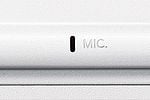
The
Microphone on the Nintendo DS Lite.
The Microphone is a feature on the Nintendo DS. On the original DS, it is at the lower left-hand corner, right below the screen. On the DS Lite, it is at the middle in between the two screens. Its function is to accept audio input. On the DSi, this position is replaced by the Camera, and the Microphone was moved about 2 cm to the right. Blowing into it will allow events to happen in the game that the player is playing, such as Toad Jump. In other games, the player must say words into the Microphone. In Mario & Sonic at the Olympic Games, the player must clap into the mic to gain inspiration from the crowd in Long Jump and Triple Jump. Also, in the game Mario & Luigi: Bowser's Inside Story, the player needs to use the microphone at certain points, such as breathing out fire as Giant Bowser.
Appearances in the Mario series
WarioWare: Touched!
The plot of WarioWare: Touched! revolves around Wario obtaining a gaming console resembling a Nintendo DS and using it to market new microgames. Occasionally, a Nintendo DS can be seen in the Pushing Buttons microgame.
Mario Kart DS
One of the battle courses in Mario Kart DS is the Nintendo DS. Also some billboards in Mario Circuit features a picture of the DS.
Mario & Luigi: Partners in Time
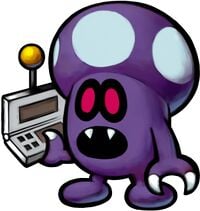
A Shroob holding a silver, flip-top communicator.
In Mario & Luigi: Partners in Time, Shroobs call Shroob UFOs by using a silver, flip-top communicator. Because the Nintendo DS has the capability to send verbal messages to friends, this may be a reference to the Nintendo DS. Additionally, Professor Elvin Gadd is shown to own a Nintendo DS with an apparent time radar he used to locate Princess Peach at the beginning of the game; he later uses the DS to operate the Hydrogush 4000.
Mario & Luigi: Bowser's Inside Story
In Mario & Luigi: Bowser's Inside Story, the Emoglobins that run the Gauntlet and Cholesteroad are shaped like DS systems. Additionally, Dark Fawful uses a device that resembles a Nintendo DS to track down the Dark Star.
WarioWare: Smooth Moves
In WarioWare: Smooth Moves, a Nintendo DS appears in the microgames Brain Age, and Wario Hunting as one of the possible baits.
Super Paper Mario
Super Paper Mario includes a computer console called the Dining Specializer, which is modeled after the Nintendo DS Lite (and can also be abbreviated "DS"). There is also a two-screened handheld that resembles a Nintendo DS known as a Training Machine, which the fortune teller Merluvlee wanted to use to train her brain (which, in turn, is a reference to the popular DS title, Brain Age and in PAL regions "Brain Training").
Mario Strikers Charged
In Mario Strikers Charged, Strikers' Times are shown on the Touch Screen of a Nintendo DS Lite.
Mario Party DS
In Mario Party DS when the player defeats Bowser at the end of the story mode, the five Sky Crystals join and form something like a crystal Nintendo DS, unlocking Triangle Twisters.
Super Smash Bros. series
Super Smash Bros. Brawl
One of the names that can appear whenever a player presses the random button when they're naming their custom stage is "DS". Also, a stage based on the PictoChat included in the Nintendo DS makes an appearance in Super Smash Bros. Brawl, complete with its very own DS emblem. Finally, in the Trophy Hoard option, a black Nintendo DS Lite appears in the background with the presents.
Super Smash Bros. for Nintendo 3DS
Super Smash Bros. for Nintendo 3DS features a successor to the original PictoChat stage, PictoChat 2.
Donkey Kong Country Returns
In Donkey Kong Country Returns, if left idle for long enough, Donkey Kong will pull out a Nintendo DS Lite to play a game.
Luigi's Mansion: Dark Moon
In Luigi's Mansion: Dark Moon, Luigi uses a device called the Dual Scream to communicate with Professor Elvin Gadd. The Dual Scream is essentially the equivalent of the Game Boy Horror (similar to a Game Boy Color) that Luigi uses in Luigi's Mansion.
Galleries
System gallery
Prototype model shown at E3 2004.
Electric Blue Nintendo DS.
A black Nintendo DS Lite.
A turquoise Nintendo DS Lite.
A regular North American charger for the Nintendo DS Lite.
The home menu (Nintendo DS and Nintendo DS Lite models)
Game gallery
Mario Kart DS Box (North America).png
NewSuperMarioBrothers.jpg
Trivia
- If the DS or DS Lite is turned on on the date that the user has set as their birthday, a high pitched chime will play. The DSi and DSi XL will not do this.
- At one point, a special "Pink Ribbon" Nintendo DS Lite was released in late September 2008. For every one bought, $5 would be donated to the Inflammatory Breast Cancer Association.
- One of the possible names for the DS was City Boy. This name made it possible for Nintendo to continue the Game Boy brand (seen as a child's toy) while trying to appeal to an urban young adult crowd.
- The Nintendo DS is the only handheld system to have neither a Player's Choice or Nintendo Selects label on select video games.
References
Nintendo DS coverage on other
NIWA wikis:
Template:BoxTop
Template:Consoles
![]() ,
, ![]() ,
, ![]() ,
, ![]() ,
, and
buttons from the Game Boy Advance, plus two new buttons:
![]() and
and ![]() , making it identical to the SNES.
, making it identical to the SNES.

